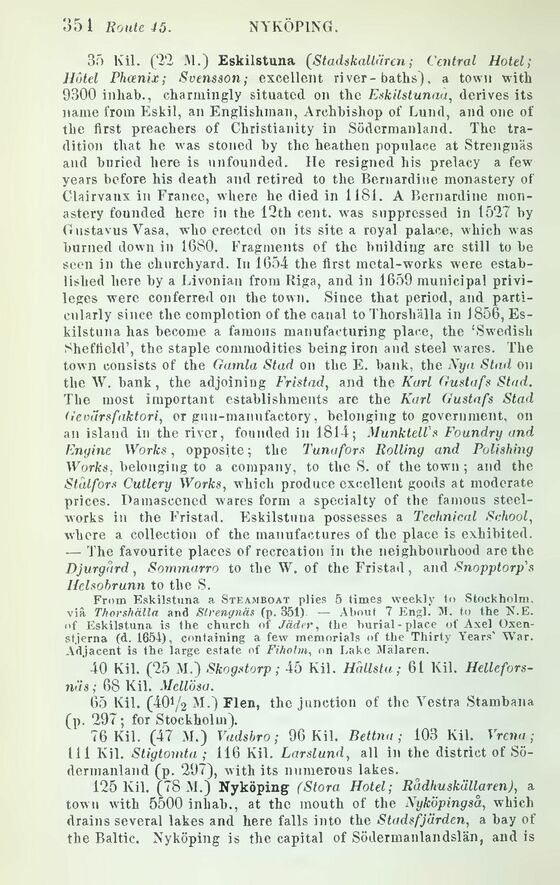
Full resolution (JPEG) - On this page / på denna sida - Sweden - Pages ...

<< prev. page << föreg. sida << >> nästa sida >> next page >>
Below is the raw OCR text
from the above scanned image.
Do you see an error? Proofread the page now!
Här nedan syns maskintolkade texten från faksimilbilden ovan.
Ser du något fel? Korrekturläs sidan nu!
This page has never been proofread. / Denna sida har aldrig korrekturlästs.
35 Kil. (22 M.) Eskilstuna (Stadskulturen; Central Hotel;
Hotel Pheenix; Svensson; excellent river-baths). a town with
9300 inhab., charmingly situated on the Eskilstunau, derives its
name from Eskil, an Englishman, Archbishop of Lund, and one of
the first preachers of Christianity in Södermanland. The
tradition that he was stoned by the heathen populace at Strengnäs
and buried here is unfounded. He resigned his prelacy a few
years before his death and retired to the Bernardine monastery of
Clairvanx in France, where he died in 1181. A Bernardine
monastery founded here in the 12th cent, was suppressed in 1527 by
Gustavus Vasa, who erected on its site a royal palace, which was
burned down in 1680. Fragments of the building are still to be
seen in the churchyard. In 1654 the first metal-works were
established here by a Livonian from Riga, and in 1659 municipal
privileges were conferred on the town. Since that period, and
particularly since the completion of the canal to Thorshalla in 1856,
Eskilstuna has become a famous manufacturing place, the ‘Swedish
Sheffield’, the staple commodities being iron and steel wares. The
town consists of the Gamla Stad on the E. bank, the Nya Stad on
the W. bank, the adjoining Fristad, and the Karl Gustafs Stad.
The most important establishments are the Karl Gustafs Stad
Gevärsfaktori, or gun-manufactory, belonging to government, on
an island in the river, founded in 1814; Munktell’s Foundry and
Engine Works, opposite; the Tunafors Rolling and Polishing
Works, belonging to a company, to the S. of the town ; and the
Stdlfors Cutlery Works, which produce excellent goods at moderate
prices. Damascened wares form a specialty of the famous
steelworks in the Fristad. Eskilstuna possesses a Technical School,
where a collection of the manufactures of the place is exhibited.
— The favourite places of recreation in the neighbourhood are the
Djurgård, Sommarro to the W. of the Fristad, and Snopptorp’s
Helsohrunn to the S.
From Eskilstuna a Steamboat plies 5 times weekly to Stockholm,
via Thorshalla and Strengnäs (p. 351) — About 7 Engl. 31. to the N.E.
of Eskilstuna is the church of Jäder, the burial-place of Axel
Oxen-st.jerna (d. 1654), containing a few memorials of the Thirty Years’ War.
Adjacent is the large estate of Fiholm, on Lake Slalaren.
40 Kil. (25 M.) Skogstorp; 45 Kil. Hållstu; 61 Kil.
Hellefors-näs; 68 Kil. Mellösa.
65 Kil. (40^2 M.) Elen, the junction of the Yestra Stambana
(p. 297; for Stockholm).
76 Kil. (47 M.) Vadshro; 96 Kil. Bettna ; 103 Kil. Vrena;
111 Kil. Stigtonita; 116 Kil. Larslund, all in the district of
Södermanland (p. 297), with its numerous lakes.
125 Kil. (78M.) Nyköping (Stora Hotel; Rådhuskällaren), a
town with 5500 inhab., at the mouth of the Nyköpingså, which
drains several lakes and here falls into the Stadsfjärden, a bay of
the Baltic. Nyköping is the capital of Södermanlandslän, and is
<< prev. page << föreg. sida << >> nästa sida >> next page >>